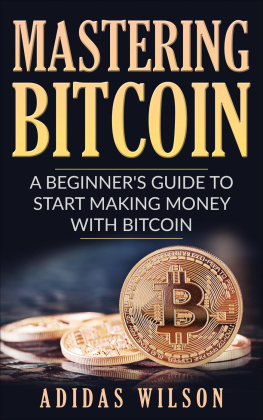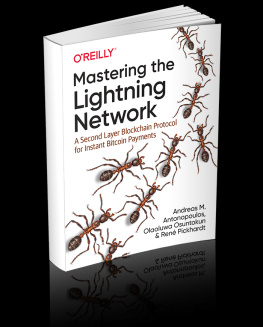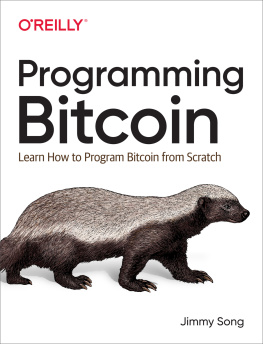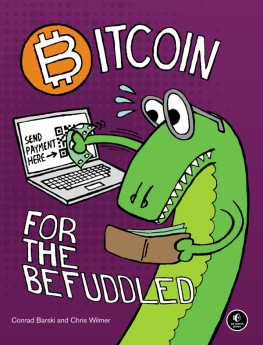Jimmy Song [Jimmy Song] - Programming Bitcoin
Here you can read online Jimmy Song [Jimmy Song] - Programming Bitcoin full text of the book (entire story) in english for free. Download pdf and epub, get meaning, cover and reviews about this ebook. year: 2019, publisher: O’Reilly Media, Inc., genre: Children. Description of the work, (preface) as well as reviews are available. Best literature library LitArk.com created for fans of good reading and offers a wide selection of genres:
Romance novel
Science fiction
Adventure
Detective
Science
History
Home and family
Prose
Art
Politics
Computer
Non-fiction
Religion
Business
Children
Humor
Choose a favorite category and find really read worthwhile books. Enjoy immersion in the world of imagination, feel the emotions of the characters or learn something new for yourself, make an fascinating discovery.
- Book:Programming Bitcoin
- Author:
- Publisher:O’Reilly Media, Inc.
- Genre:
- Year:2019
- Rating:5 / 5
- Favourites:Add to favourites
- Your mark:
Programming Bitcoin: summary, description and annotation
We offer to read an annotation, description, summary or preface (depends on what the author of the book "Programming Bitcoin" wrote himself). If you haven't found the necessary information about the book — write in the comments, we will try to find it.
With Early Release ebooks, you get books in their earliest formthe authors raw and unedited content as he or she writesso you can take advantage of these technologies long before the official release of these titles. Youll also receive updates when significant changes are made, new chapters are available, and the final ebook bundle is released.
Learn how to program a Bitcoin library with this hands-on guide from one of the leading teachers on bitcoin and bitcoin programming. Author Jimmy Song shows you the basics, including the math, blocks, network, and transactions behind this popular cryptocurrency and its blockchain payment system. Youll also learn how simplified payment verification and how proof-of-work works.
This book is ideal for programmers looking to change the course of their careers, enterprises exploring Bitcoin applications, and students taking a college-level class. You can use this book as training tool to help you learn Bitcoin concepts and then as a handy reference guide once you start to build your Bitcoin library.
Youll learn how to:
- Parse, validate, and create Bitcoin transactions
- Use the Script smart contract language
- Verify proof-of-work to secure the blockchain
- Use Python libraries to program Bitcoin
- Create your own testnet transaction
- Understand simplified payment verification and learn how light wallets work
- Explore public key cryptography at a fundamental level
Jimmy Song [Jimmy Song]: author's other books
Who wrote Programming Bitcoin? Find out the surname, the name of the author of the book and a list of all author's works by series.

![Jimmy Song [Jimmy Song] Programming Bitcoin](/uploads/posts/book/119685/thumbs/jimmy-song-jimmy-song-programming-bitcoin.jpg)





![Harish Kumar Garg [Harish Kumar Garg] - Hands-On Bitcoin Programming with Python](/uploads/posts/book/119676/thumbs/harish-kumar-garg-harish-kumar-garg-hands-on.jpg)
